
0151 420 6563
Cavity Wall Tie Replacement
Cavity Wall Tie Surveys & Remedial Work
What is a Cavity Wall?
Cavity walls are a common form of brickwork, most dwellings built after 1920’s will be of cavity wall construction. Cavity walls consist of two separate leaves, internal and external which are tied together by Cavity Wall Ties. Cavity walls have many benefits such as, providing better thermal insulation also helping prevent penetrating moisture ingress due to the space between leaves and the use of weep holes.

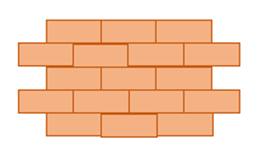
Typical Cavity Wall Construction
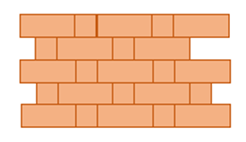
Typical Solid Wall Construction
Cavity Wall Ties
Wall ties are a necessary component within a cavity wall construction. Spaced equally throughout the span of the wall, they are designed to tie the internal and external leaves together to help keep the structure safe and stable.

The image above is from a wall tie survey undertaken by Halton Construction, it shows a severely corroded heavy gauged fish ail metal wall tie, in its ash based mortar bed joint.
Cavity Wall Tie Failure
Wall tie failure is a common problem, steel and iron are the most regular materials used for wall ties. Failure may be a result of poor workmanship during construction, rusting/corrosion or a chemical reaction where black ash mortar is used. Black ash-based mortar is commonly found in older buildings, the aggressive nature of the mortar due to the high sulphur properties may attack the galvanised coating of the wall ties and the metal, resulting in failure of the ties.
Maintaining the quality of wall ties is essential as failure may make dwellings less weathertight or cause a potential danger to occupants and passers-by as the structure may become unstable. Vertical or horizontal cracks in brickwork and mortar joints, Bulging brickwork, Cracks or Separation of window reveals or Sagging of lintels within the structure may indicate wall tie failure.
Professional diagnosis alongside specialist equipment is required to investigate suspected wall tie failure, in order to advise on remedial works before the issue escalates.
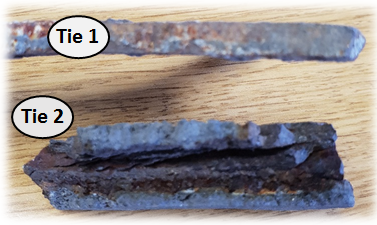
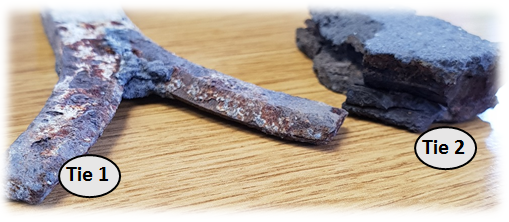
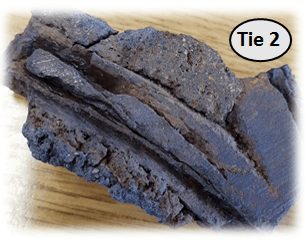
The images show wall ties that were taken from remedial wall tie works, undertaken by Halton Construction. As you can see from the images the level of corrosion is varied, tie 2 has expanded significantly showing a higher rate of failure. A corroding metal tie may expand up to 7 times its original size, this results in many defects within the structure.
Halton Construction
can provide the necessary high-quality services required, in order to investigate suspected wall tie failure. The condition of wall ties can only be judged by visual inspection of the metal tie. This can either be done by using an advanced optical borescope or by removing the brickwork or mortar from the external leaf of the wall. A detailed survey report will be produced, with recommendations regarding the condition of the wall ties and any remedial works.
Wall tie surveys carried out by Halton Construction start at £200.00 + VAT
Our company is a member of the Wall Tie Installers Federation and can offer a 25-year insurance backed guarantee from the federation. All our wall tie work is carried out in accordance with BRE Digest No. 329 and No. 401, including appropriate pull testing.
Pull testing- This testing applies tension on a newly installed wall tie to help identify the load capacity before failure occurs to ensure the ties are suitable for use.

Structural Alterations & Repairs
For more wall tie related repairs click on the link above.
For more information or to book a survey please call our office on:
0151 420 6563
© 2024. The content on this website is owned by us and our licensors. Do not copy any content (including images) without our consent.
